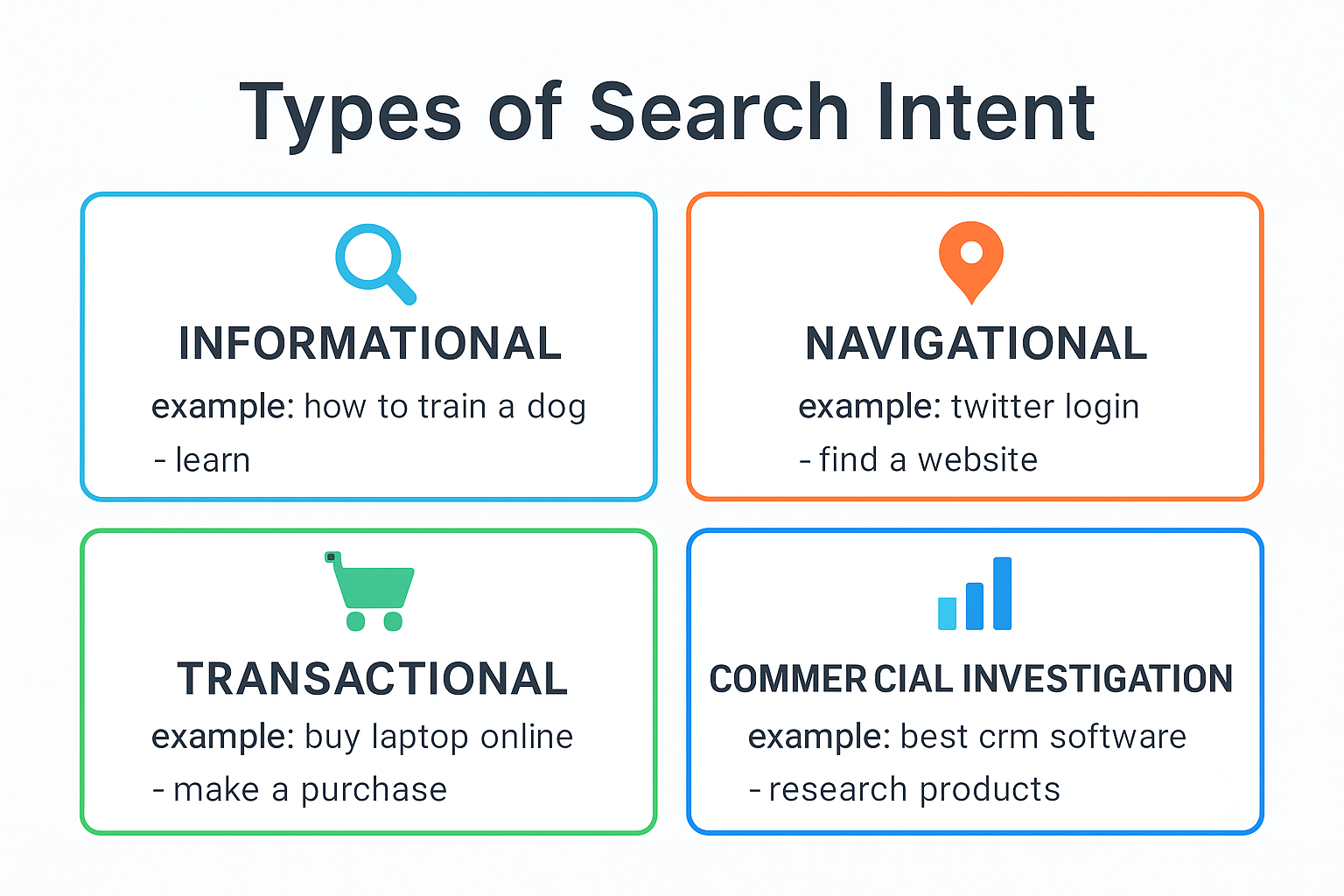Search engines process billions of queries every day and what really drives these searches is user intent. Most people assume stuffing keywords onto a page is all it takes to rank but that misses the mark in a big way. Nearly 80 percent of all web queries are driven by informational intent alone. When you truly understand what someone hopes to get out of their search, you can craft content that stands out and actually gets seen.
Table of Contents
- Understanding Search Intent In SEO
- The Main Types Of Search Intent
- How To Identify User Search Intent
- Optimizing Content For Search Intent
Quick Summary
| Takeaway | Explanation |
|---|---|
| Understand the four search intent types | Familiarize yourself with informational, navigational, transactional, and commercial investigation intents to optimize content effectively. |
| Optimize content for specific intents | Tailor your content approach based on whether it’s aimed at providing information, driving transactions, or supporting comparisons. |
| Use SERP analysis for intent insights | Analyze search engine result pages to gauge what type of content aligns with user queries and adjust your strategies accordingly. |
| Incorporate strong structural elements | Use descriptive headings and a logical hierarchy to help users quickly locate the information they need, enhancing their experience. |
| Continuously refine your content | Regularly assess performance metrics and user feedback to adapt content strategies to changing search behaviors and user needs. |
Understanding Search Intent in SEO
Search intent represents the core motivation behind a user’s online query and plays a pivotal role in modern search engine optimization strategies. At its fundamental level, search intent reveals why someone is searching and what specific information or outcome they hope to achieve through their search.
The Four Primary Search Intent Categories
Understanding search intent requires recognizing the primary categories that define user search behaviors. Research from the University of Minnesota categorizes search queries into four distinct types that help digital marketers and content creators align their strategies more effectively:
Here’s a summary table outlining the four primary types of search intent, their key characteristics, and example queries. This table helps clarify the distinctions between each intent type for quick reference.
| Search Intent Type | Key Characteristics | Example Queries |
|---|---|---|
| Informational | Seeking knowledge or answers; educational focus | “how to change a car tire” |
| Navigational | Looking for a specific website or page | “Facebook login” |
| Transactional | Ready to make a purchase or complete an action | “buy running shoes online” |
| Commercial Investigation | Researching, comparing, or reading reviews | “best laptops 2024 reviews” |

- Informational Intent: Users seeking knowledge or answers to specific questions. These searches typically begin with phrases like “how to,” “what is,” or “why does.”
- Navigational Intent: Users looking to reach a specific website or webpage. They often search for brand names or exact website addresses.
- Transactional Intent: Users ready to make a purchase or complete a specific action. These searches frequently include terms like “buy,” “price,” or “discount.”
- Commercial Investigation Intent: Users researching products or services before making a purchase decision. These queries often involve comparisons, reviews, and evaluations.
Why Search Intent Matters for SEO
According to Wikipedia’s overview of user intent, recognizing search intent is crucial for optimizing content to meet user needs and improve search engine rankings. Search engines like Google have sophisticated algorithms that analyze user behavior and content relevance to determine the most appropriate search results.
When content precisely matches the user’s search intent, several significant benefits emerge. Websites can experience improved engagement metrics, lower bounce rates, and higher rankings. Search engines reward content that effectively addresses user queries by positioning it more prominently in search results.
For SEO professionals and content creators, this means going beyond traditional keyword optimization. Instead of merely targeting specific keywords, the focus shifts to understanding the underlying user motivation. This approach requires deep empathy with the target audience and a nuanced understanding of their search behaviors.
For instance, a search query for “running shoes” could indicate different intents: someone might be researching running shoe technologies, comparing prices, or looking to make an immediate purchase. By creating content that addresses multiple potential intents, websites can capture a broader audience and provide more comprehensive value.
Learn more about advanced SEO techniques for semantic search to further refine your understanding of how search engines interpret user intent and content relevance.
Mastering search intent is not a one time achievement but an ongoing process of understanding user needs, analyzing search patterns, and continuously adapting content strategies. By placing user intent at the center of SEO efforts, digital marketers can create more targeted, valuable, and successful online experiences.
The Main Types of Search Intent
Research from Penn State University reveals that web searches can be systematically categorized into distinct intent types, each representing a unique user motivation and information-seeking behavior. Understanding these types allows SEO professionals to craft more targeted and effective content strategies.
Informational Search Intent
Informational search intent represents the most prevalent type of online search, accounting for approximately 80% of all web queries. Users conducting informational searches are primarily seeking knowledge, answers, or detailed explanations about a specific topic. These searches typically begin with investigative phrases like “how to,” “what is,” “why does,” or “best ways to.”
For example, a user searching “how to change a car tire” demonstrates pure informational intent. They are not looking to purchase anything but seeking step-by-step guidance or educational content. According to the University of Minnesota, informational searches are characterized by their quest for understanding and learning.
Transactional and Navigational Search Intents
Transactional search intent signals a user’s readiness to complete a specific action, most commonly a purchase. These searches include terms like “buy,” “price,” “discount,” or “order online.” Unlike informational searches, transactional queries indicate high purchase intent and commercial motivation.
Navigational search intent represents users seeking a specific website or webpage. These searches often involve brand names or direct website URLs. For instance, searching “Facebook login” or “Amazon customer service” demonstrates clear navigational intent where users want to reach a particular online destination.
Commercial Investigation Search Intent
Commercial investigation search intent occupies a unique space between informational and transactional searches. Users conducting these searches are in the research phase, comparing products, reading reviews, and gathering information before making a purchase decision. These queries often include terms like “best,” “top,” “reviews,” or “compare.”
Learn more about advanced search query analysis to understand the nuanced differences between search intent categories.
Understanding these search intent types is crucial for developing content that precisely matches user expectations. By recognizing the underlying motivation behind each search, marketers and content creators can develop more targeted strategies that improve user experience, increase engagement, and ultimately drive better search engine rankings.
The key is not just to recognize these intent types but to develop a dynamic, adaptable approach that considers the evolving nature of user search behaviors. Search intent is not static it continually shifts with technological advancements, user preferences, and emerging digital trends.
How to Identify User Search Intent
Identifying user search intent requires a strategic approach that combines multiple analytical techniques and deep understanding of user behavior. Research from ResearchGate highlights the complexity of deciphering the underlying motivations behind search queries.
The table below summarizes key techniques for identifying user search intent, including their main focus and examples. This provides a quick reference to the primary methods described in the article.
| Identification Method | Main Focus or Data Source | Example Application |
|---|---|---|
| Query Language & Keywords Analysis | Examining words/phrases in search queries | Identifying intent via terms like “buy” |
| SERP Analysis | Reviewing search result types shown by engines | Checking if results are products/articles |
| Advanced Behavioral Techniques | Analyzing user actions and demographic data | Looking at CTRs, time on page, search patterns |
Analyzing Query Language and Keywords
The first step in identifying search intent involves carefully examining the specific language and keywords used in a search query. Different phrases and word choices provide critical clues about the user’s underlying motivation. For instance, queries containing words like “how to” typically indicate informational intent, while phrases such as “buy” or “price” suggest transactional intent.
Some key linguistic indicators include:
- Informational Queries: “what is,” “how do,” “guide to,” “explain”
- Transactional Queries: “purchase,” “order,” “buy,” “pricing”
- Navigational Queries: Brand names, specific website addresses
- Commercial Investigation Queries: “best,” “reviews,” “top 10,” “comparison”
Utilizing Search Engine Results Page (SERP) Analysis
Search engine results pages provide invaluable insights into search intent. By examining the types of content Google and other search engines prioritize for specific queries, marketers can gain a deeper understanding of the perceived user intent behind those searches.
For example, if a search query returns primarily product pages, it suggests a strong transactional intent. Conversely, if the results are predominantly informational articles or tutorials, the search intent is likely informational. This method allows for a data-driven approach to understanding user motivation.
Advanced Techniques for Intent Identification
More sophisticated methods of identifying search intent involve analyzing user behavior, search history, and contextual cues. Advanced analytics tools can help decode the nuanced motivations behind search queries by examining:
- Historical search patterns
- Click-through rates
- Time spent on different types of content
- User demographic information
- Device and location-based context
Explore advanced SEO techniques for deeper search analysis to refine your understanding of user search behaviors.
Successfully identifying search intent is not a one-size-fits-all process. It requires continuous learning, adaptation, and a willingness to dive deep into user behavior. SEO professionals must remain flexible, constantly updating their strategies as search technologies evolve and user behaviors shift.
The most effective approach combines multiple methodologies: linguistic analysis, SERP examination, behavioral insights, and ongoing data interpretation. By developing a comprehensive understanding of search intent, marketers can create more targeted, relevant content that truly meets user needs and improves overall search performance.
Optimizing Content for Search Intent
Research from the University of Nebraska demonstrates that successfully optimizing content for search intent requires a strategic and nuanced approach. The goal is to create content that precisely matches user expectations and addresses their specific information needs across different search intent categories.
Crafting Content for Specific Search Intents
Each search intent type demands a unique content strategy. For informational queries, focus on creating comprehensive, educational content that provides clear, detailed answers. This means developing in-depth guides, tutorials, and explanatory articles that thoroughly address user questions.
Transactional intent content should prioritize clear value propositions, product details, pricing information, and straightforward purchasing pathways. Include elements like product specifications, pricing comparisons, customer reviews, and direct call-to-action buttons that facilitate immediate user action.
For commercial investigation searches, develop content that offers balanced, objective comparisons. This might include detailed product reviews, feature breakdowns, pros and cons analyses, and expert recommendations that help users make informed decisions.
Structural Optimization Techniques
Content structure plays a crucial role in meeting search intent. Use clear, descriptive headings that directly address potential user questions. Implement a logical content hierarchy that allows readers to quickly find the information they seek. This includes:
- Using descriptive H1 and H2 headings
- Creating scannable content with bullet points and short paragraphs
- Including a table of contents for longer, comprehensive pieces
- Utilizing multimedia elements like images, videos, and infographics
Ensure that the most critical information appears early in the content, following the inverted pyramid principle used in journalistic writing. This approach helps users quickly determine if the content meets their specific search intent.
Advanced Content Alignment Strategies
Beyond basic optimization, advanced content strategies involve deeper user intent understanding. This means going beyond surface-level keyword matching and truly addressing the underlying user motivation.
Explore advanced content optimization techniques to elevate your search intent strategy.
Consider the user’s potential follow-up questions and proactively address them within your content. For informational queries, this might mean providing additional resources or links to related topics. For transactional searches, include comprehensive purchasing guidance, shipping information, and potential alternative solutions.
Technology and user behaviors evolve rapidly, making continuous content refinement essential. Regularly analyze your content’s performance using metrics like bounce rate, time on page, and conversion rates. These insights will help you understand how well your content truly meets user search intent.
Successful search intent optimization is not a one-time task but an ongoing process of understanding, adapting, and improving. By maintaining a user-centric approach and remaining responsive to changing search behaviors, you can create content that not only ranks well but genuinely serves user needs.

Frequently Asked Questions
What is search intent in SEO?
Search intent refers to the underlying motivation that drives a user to perform a search query. It helps SEO professionals understand what users are looking for, allowing them to create content that meets those needs effectively.
Why is understanding search intent important for SEO?
Understanding search intent is crucial because it allows websites to align their content with what users are genuinely seeking. By optimizing for specific intents, websites can improve engagement, lower bounce rates, and enhance their search engine rankings.
How can I identify user search intent?
User search intent can be identified by analyzing the language and keywords used in search queries, reviewing search engine results pages (SERPs) for content types, and examining user behavior through metrics like click-through rates and time spent on pages.
What are the main types of search intents?
The main types of search intents include informational intent (seeking knowledge), navigational intent (looking for a specific site), transactional intent (ready to make a purchase), and commercial investigation intent (researching and comparing products before a purchase).
Eliminate Keyword Confusion and Match True Search Intent Fast
You have learned that matching content to user intent is critical for SEO success. But even when you understand search intent types, keyword cannibalization and overlapping topics can silently sabotage your rankings. Many content creators struggle to identify which page best serves each intent, and this leads to poor engagement, lost opportunities, and lower visibility. If you are ready to optimize your site and make every page count, take control of your keyword strategy now.
Get clarity on your entire keyword landscape. RankAligner is trusted by top SEO consultants and agencies to quickly spot cannibalization issues and ensure every URL meets the right search intent. Visit https://rankaligner.com today and see how easy it is to boost your rankings with powerful search intent analysis. Do not let misaligned content waste another click—start optimizing your intent-focused SEO strategy now.
Recommended
- Semantic Search Explained: Boost SEO Results in 2025 – Rank Aligner – Your Ultimate Keyword Cannibalization Problem Solver
- Search Engine History: Key Milestones and Impact in 2025 – Rank Aligner – Your Ultimate Keyword Cannibalization Problem Solver
- SEO Tips for Ecommerce: Proven Strategies for 2025 – Rank Aligner – Your Ultimate Keyword Cannibalization Problem Solver
- Top SEO Ranking Factors 2025: A Guide for Consultants – Rank Aligner – Your Ultimate Keyword Cannibalization Problem Solver

